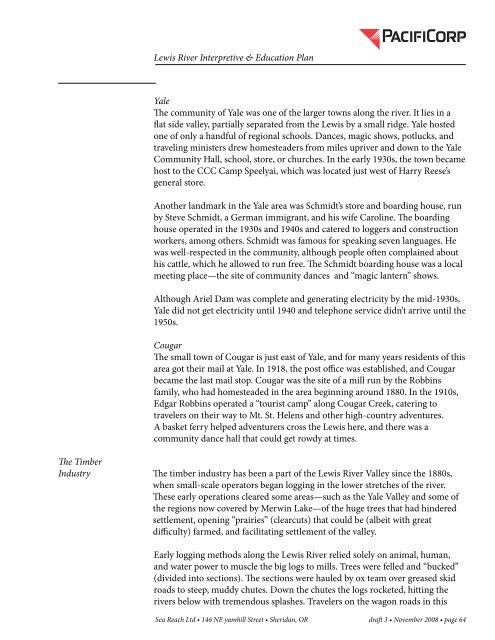The Lewis River Hydroelectric Projects - PacifiCorp
The Lewis River Hydroelectric Projects - PacifiCorp
The Lewis River Hydroelectric Projects - PacifiCorp
You also want an ePaper? Increase the reach of your titles
YUMPU automatically turns print PDFs into web optimized ePapers that Google loves.
<strong>Lewis</strong> <strong>River</strong> Interpretive & Education Plan<br />
Yale<br />
<strong>The</strong> community of Yale was one of the larger towns along the river. It lies in a<br />
flat side valley, partially separated from the <strong>Lewis</strong> by a small ridge. Yale hosted<br />
one of only a handful of regional schools. Dances, magic shows, potlucks, and<br />
traveling ministers drew homesteaders from miles upriver and down to the Yale<br />
Community Hall, school, store, or churches. In the early 1930s, the town became<br />
host to the CCC Camp Speelyai, which was located just west of Harry Reese’s<br />
general store.<br />
Another landmark in the Yale area was Schmidt’s store and boarding house, run<br />
by Steve Schmidt, a German immigrant, and his wife Caroline. <strong>The</strong> boarding<br />
house operated in the 1930s and 1940s and catered to loggers and construction<br />
workers, among others. Schmidt was famous for speaking seven languages. He<br />
was well-respected in the community, although people often complained about<br />
his cattle, which he allowed to run free. <strong>The</strong> Schmidt boarding house was a local<br />
meeting place—the site of community dances and “magic lantern” shows.<br />
Although Ariel Dam was complete and generating electricity by the mid-1930s,<br />
Yale did not get electricity until 1940 and telephone service didn’t arrive until the<br />
1950s.<br />
Cougar<br />
<strong>The</strong> small town of Cougar is just east of Yale, and for many years residents of this<br />
area got their mail at Yale. In 1918, the post office was established, and Cougar<br />
became the last mail stop. Cougar was the site of a mill run by the Robbins<br />
family, who had homesteaded in the area beginning around 1880. In the 1910s,<br />
Edgar Robbins operated a “tourist camp” along Cougar Creek, catering to<br />
travelers on their way to Mt. St. Helens and other high-country adventures.<br />
A basket ferry helped adventurers cross the <strong>Lewis</strong> here, and there was a<br />
community dance hall that could get rowdy at times.<br />
<strong>The</strong> Timber<br />
Industry <strong>The</strong> timber industry has been a part of the <strong>Lewis</strong> <strong>River</strong> Valley since the 1880s,<br />
when small-scale operators began logging in the lower stretches of the river.<br />
<strong>The</strong>se early operations cleared some areas—such as the Yale Valley and some of<br />
the regions now covered by Merwin Lake—of the huge trees that had hindered<br />
settlement, opening “prairies” (clearcuts) that could be (albeit with great<br />
difficulty) farmed, and facilitating settlement of the valley.<br />
Early logging methods along the <strong>Lewis</strong> <strong>River</strong> relied solely on animal, human,<br />
and water power to muscle the big logs to mills. Trees were felled and “bucked”<br />
(divided into sections). <strong>The</strong> sections were hauled by ox team over greased skid<br />
roads to steep, muddy chutes. Down the chutes the logs rocketed, hitting the<br />
rivers below with tremendous splashes. Travelers on the wagon roads in this<br />
Sea Reach Ltd • 146 NE yamhill Street • Sheridan, OR draft 3 • November 2008 • page 64
















